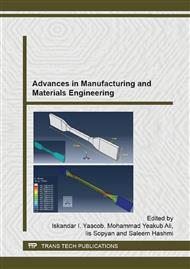[1]
R. Quiza Sardiñas, M. Rivas Santana & E. Alfonso Brindis (2006). Genetic algorithm-based multi-objective optimization of cutting parameters in turning processes. Engineering Applications of Artificial Intelligence, 19(2), 127-133.
DOI: 10.1016/j.engappai.2005.06.007
Google Scholar
[2]
N. Ahmad, T. Tanaka, & Y. Saito, (2011). Optimization of multipass turning parameters by genetic algorithm. Advanced Materials Research, 264, 1545-1550.
DOI: 10.4028/www.scientific.net/amr.264-265.1545
Google Scholar
[3]
M. Hrelja, S., KlancnikIrgolic, T., Paulic, M., Jurkovic, Z., Balic, J., & Brezocnik, M. (2014). Particle swarm optimization approach for modelling a turning process. electronic form only: NE.
DOI: 10.14743/apem2014.1.173
Google Scholar
[4]
R. Venkata Rao, & V. D. Kalyankar, (2013). Multi-pass turning process parameter optimization using teaching–learning-based optimization algorithm. Scientia Iranica, 20(3), 967-974.
DOI: 10.1016/j.scient.2013.01.002
Google Scholar
[5]
S. Kara, & W. Li, (2011). Unit process energy consumption models for material removal processes. CIRP Annals-Manufacturing Technology, 60(1), 37-40.
DOI: 10.1016/j.cirp.2011.03.018
Google Scholar
[6]
R. K. Bhushan, (2013). Optimization of cutting parameters for minimizing power consumption and maximizing tool life during machining of Al alloy SiC particle composites. Journal of Cleaner Production, 39, 242-254.
DOI: 10.1016/j.jclepro.2012.08.008
Google Scholar
[7]
A. Aggarwal, H. Singh, P. Kumar, & M. Singh, (2008). Optimizing power consumption for CNC turned parts using response surface methodology and Taguchi's technique—a comparative analysis. Journal of materials processing technology, 200(1), 373-384.
DOI: 10.1016/j.jmatprotec.2007.09.041
Google Scholar
[8]
M. F. Rajemi, P. T. Mativenga, & A. Aramcharoen, (2010). Sustainable machining: selection of optimum turning conditions based on minimum energy considerations. Journal of Cleaner Production, 18(10), 1059-1065.
DOI: 10.1016/j.jclepro.2010.01.025
Google Scholar
[9]
M.F., Rajemi, P.T., Mativenga & S.I. Jaffery, 2009. Energy and carbon footprint analysis for machining titanium Ti-6Al-4V Alloy. Journal of Machine Engineering 9 (1), 103–112.
Google Scholar
[10]
M.H.F. Al Hazza, E Y T Adesta, Riza, M., & Suprianto, M. Y. (2012). Power Consumption Optimization in CNC Turning Process Using Multi Objective Genetic Algorithm. Advanced Materials Research, 576, 95-98.
DOI: 10.4028/www.scientific.net/amr.576.95
Google Scholar
[11]
E.Y. T, Adesta, & M.H.F. Al Hazza, (2011). Machining Time Simulation in High Speed Hard Turning. Advanced Materials Research, 264, 1102-1106.
DOI: 10.4028/www.scientific.net/amr.264-265.1102
Google Scholar
[12]
Kirkpatrick, S. (1984). Optimization by simulated annealing: Quantitative studies. Journal of statistical physics, 34(5-6), 975-986.
DOI: 10.1007/bf01009452
Google Scholar
[13]
S. Kirkpatrick; C. D. Gelatt; M. P. Vecchi (1983). Optimization by simulated annealing. science, 220(4598), 671-680.
DOI: 10.1126/science.220.4598.671
Google Scholar


